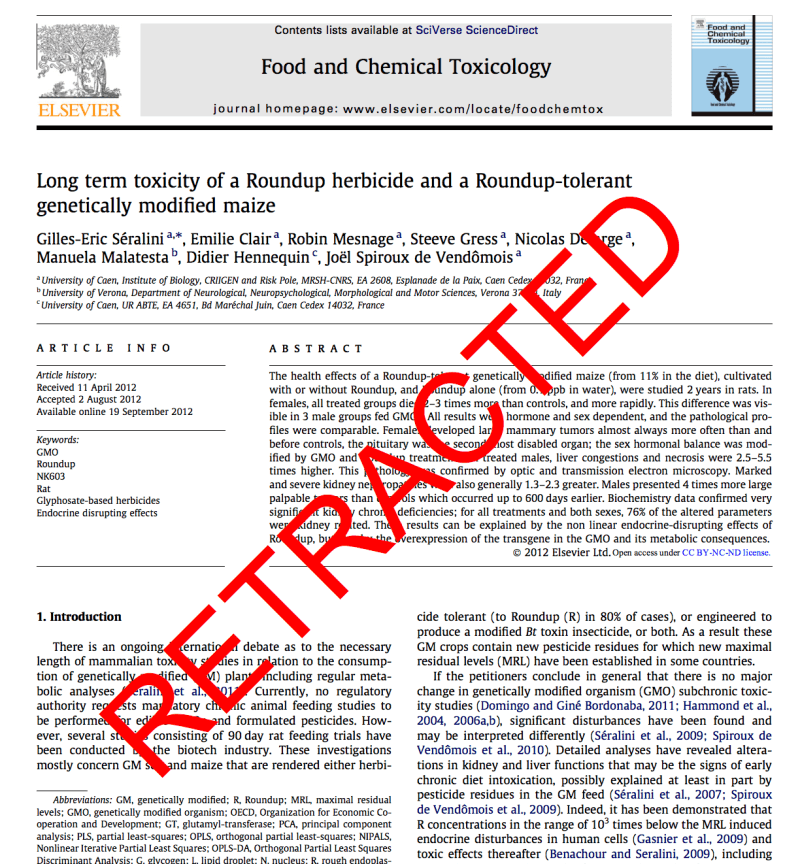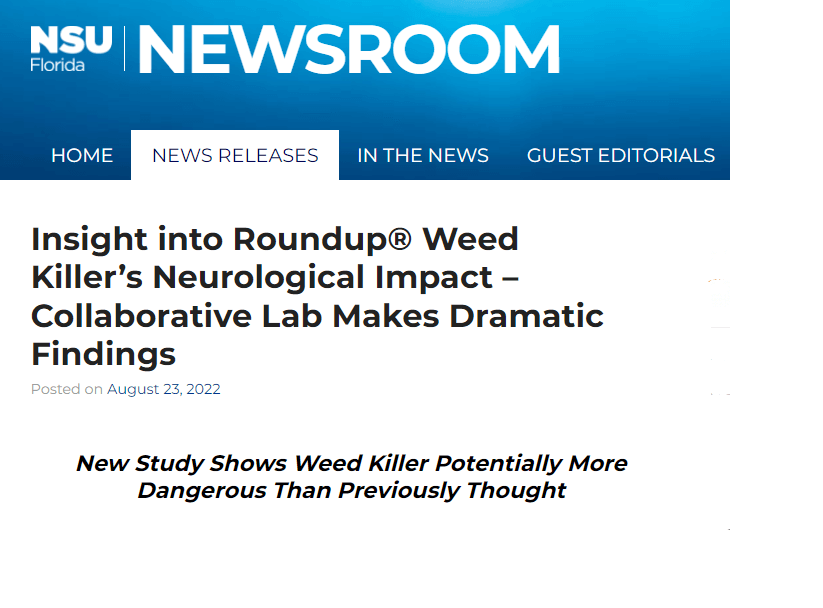
Scrolling through the news has become a game of “What Great Horror Did Glyphosate Wreak This Week?” Variations on “Study first to link weed killer Roundup to convulsions in animals” regularly blaze across the internet. It only took this breathless news release from Florida Atlantic University accompanying an open access study in the journal Scientific Reports.
The headlines and stories that resulted appeared uncritically on hundreds of many mainstream websites (e.g., here, here, here, here, etc.) and on YouTube.
Anti-biotechnology activists had a field day, as you might guess (here, here).
The entire paper and the hysteria-grams were based on a study focused on…worms.
What’s the context?
Over the past fifty years scientists, many of the activist inclination, have been feeding the weedkiller Roundup and its active ingredient glyphosate to rats, mice, worms, bees and any critter they could jam it into in the mostly futile hope to find something nefarious. The finding most celebrated by critics of the weedkiller, and which is still circulated today, was retracted. Why? Because it manipulated science to try to prove an ideological point — and the authors got caught.

Over the years, in an attempt to ‘prove’ glyphosate’s danger, scientists delivered massive doses through tubes directly into the stomach and injecting it directly into the abdomens of rodents. In the hundreds of papers in which animals have been exposed to these unrealistically high doses there has been no mention of convulsions, except in some case studies where people drank huge amounts of the concentrate in failed suicide attempts. A systematic review of 27 studies released last year focused on whether glyphosate had any neurological effects in animals, published in June, shows little reliable evidence of impacts.

On top of that, while we’re constantly reminded that there is more glyphosate applied than ever before, there are no trends of applicators and farmers breaking out in seizures (if there were, you can be assured they’d be the subject of high-profile lawsuits).
So being the “first to link” glyphosate to animal convulsions either means: (a) everyone else must have missed it for half a century; or (b) it could be an observation dependent on the experiment or the organism being tested. But presenting a measured analysis and making it clear that literally no other of the 3,000+ studies on glyphosate over more than 50 years has reached a similar conclusion, is not nearly as much fun as a new horror story.
What did the report really say?
The headlines suggested that the herbicide was “harmful” and was “linked” to convulsions in “animals”. Is that true?
The report by Naraine et al examined the recovery of C. elegans (a laboratory version of a ubiquitous microscopic soil worm) after an electric shock. When the worms are pulsed with electricity they go into a seizure, breaking their normal swimming behaviors. The time to recover from the shock was recorded. The researchers observed that shock-induced paralysis lasted longer when worms were bathed in glyphosate. In other words, glyphosate did not cause the convulsions as many headlines inferred.

The researchers then went on to test recovery in the presence of specific drugs or genetic mutations that could block or hypersensitize discrete neurotransmitter receptors in the worm’s rudimentary nervous system of 302 neurons. The results were consistent with glyphosate interfering with a specific neurotransmitter and/or its receptor, the GABA-A receptor, to cause the augmented recovery time. The scientists used both genetics and drugs to affect the response, a strong approach that helps pinpoint a mechanism of how glyphosate affects electroshock recovery.
Unlike other reports where researchers pack animals full of herbicide and measure effects, the researchers here were careful to test a series of glyphosate formulations at relatively low concentrations, some that a nematode might realistically encounter in an ecological setting. They also independently tested the surfactants: the detergent-like molecules in Roundup that help the herbicide penetrate the waxy coating of leaves. These didn’t extend electrically-induced convulsions. Glyphosate alone did, even in the absence of the surfactant.
My major criticism of the paper is in the easy-to-misinterpret presentation of data in bar graphs that overlaid the individual data points. There is a lot of variation in the response between worms, and the researchers only reported an average. When looking at the data in most experiments they appear almost random, with wide variation in worm behavior in both glyphosate treatments and saline controls. The average recovery time was longer in the presence of the herbicide—but that seems to be dependent on a few worms convulsing longer, not all worms showing a change. Measuring the timing of worm wiggles might be tricky business, and larger data sets might refine the differences observed.
So, let’s give the benefit of the doubt to the authors and conclude the glyphosate treated worms convulse longer and do so in a way that is dependent on a specific neurotransmitter. But let’s ostracize the sensational headlines about “dramatic findings” and the thousands of social media references and retweets hyping the glyphosate-seizure link, especially those claiming it is a basis of convulsions in “animals”.
Nova Southeastern University, one of the schools involved in the research, wins the award for irresponsibly generating unwarranted concern. Here’s its news release;

Before even introducing the study, Nova unscrupulously hyped a totally unrelated routine CDC release in July that found more than 80% of urine samples of Americans contained micro-traces of glyphosate—data blown way out of proportion, as I addressed in an article on the Genetic Literacy Project here.
Then the release breathlessly moved on to the worm study. Did the researchers really find something earth-shaking as its coverage suggested? Is glyphosate “potentially more dangerous than previously thought”? Should we rely on a study in an invertebrate model that does not match what has been observed in more complex animals with nervous systems much more similar to humans?
Other compounds known to affect specific neurotransmitters have been tested in C. elegans and show similar results with recovery time, so this is nothing new. What earth shaking nugget of information did the researchers in this case actually find? That “glyphosate and Roundup … generate concerns” over how they “might affect soil-dwelling organisms like C. elegans”—microscope soil worms. That’s the substance of the conclusion before the anti-glyphosate attack market went into high gear. To speculate that based on this study that animals including humans might be at risk is a long stretch.
We will never expect contextualized coverage of this otherwise forgettable worm study by advocacy groups like GM Watch, which predictably hyped the study in headlines accompanied by wild implications from one of the news releases, that glyphosate “could lead to neurodegenerative diseases such as Parkinson’s”—findings not found in some 3,000+ studies on glyphosate to date.
That’s not what the study addressed, and nor can its impact on other animals or humans be inferred from sparse data obtained from an electroshocked microscopic worm bathed in herbicide. That’s pure speculation, and irresponsible.
What are we to take away from this all-to-familiar glyphosate-will-harm-you “news” melodrama? It means that serious readers—and editors of responsible news publications—need to actually read a scientific paper before writing a headline or pushing out a tweet.
Kevin M. Folta is a professor, keynote speaker and podcast host. Follow Professor Folta on Twitter @kevinfolta
This article previously ran on the GLP Aug 30, 2022.
